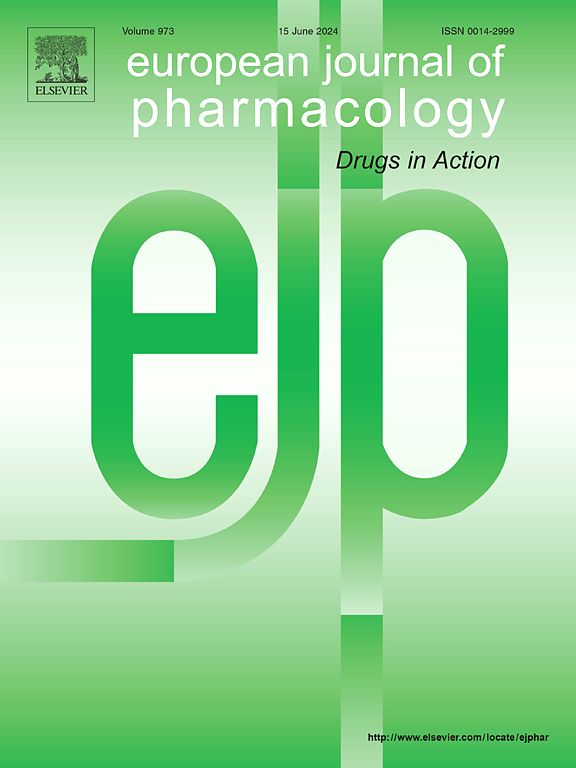Cilostazol and SB203580 combination: Targeting ER stress and p38MAPK signaling in Alzheimer's disease mouse model
IF 4.2
3区 医学
Q1 PHARMACOLOGY & PHARMACY
引用次数: 0
Abstract
Endoplasmic reticulum (ER) stress and mitogen-activated protein kinase (p38MAPK) signaling contribute to neuronal inflammation, oxidative stress, and apoptosis, driving neurodegeneration in Alzheimer's disease (AD). These pathways present potential therapeutic targets. This study evaluates the neuroprotective effects of cilostazol (CLZ), a selective phosphodiesterase 3 inhibitor, and its modulation of ER stress and p38MAPK signaling in an AD mouse model induced by AlCl3 (10 mg/kg/day, i.p.) and D-galactose (150 mg/kg/day, i.p.) for 8 weeks. CLZ (30 mg/kg, p.o.), SB203580 (a p38MAPK inhibitor, 1 mg/kg, i.p.), or their combination were administered during the final 4 weeks. Results demonstrated that CLZ, alone or in combination with SB203580, mitigated cognitive decline, preserved hippocampal neurons, reduced Tau phosphorylation, and alleviated histopathological alterations. Mechanistically, CLZ suppressed ER stress by inhibiting both the IRE1α and PERK arms of ER stress. Inhibition of IRE1α inhibited p38MAPK, leading to NF-κB suppression and decreased TNF-α levels, thereby attenuating neuroinflammation. Simultaneously, PERK inhibition downregulated CHOP/GADD153, shifting the Bax/Bcl2 balance to prevent apoptosis. Additionally, CLZ reduced oxidative stress and enhanced survival signaling via p-CREB activation. Notably, combining CLZ with SB203580 further enhanced these neuroprotective effects in an additive manner. These findings underscore CLZ's potential in targeting ER stress and neuroinflammatory pathways in AD, particularly when combined with selective p38MAPK inhibition. This study highlights a promising therapeutic strategy, warranting further investigation to develop effective treatments for AD and other neurodegenerative disorders.

西洛他唑和SB203580联合靶向阿尔茨海默病小鼠内质网应激和p38MAPK信号通路
内质网(ER)应激和丝裂原活化蛋白激酶(p38MAPK)信号通路参与神经元炎症、氧化应激和凋亡,驱动阿尔茨海默病(AD)的神经退行性变。这些途径提供了潜在的治疗靶点。本研究评估了选择性磷酸二酯酶3抑制剂西洛他唑(cilostazol, CLZ)在AlCl3 (10 mg/kg/天,i.p.)和d -半乳糖(150 mg/kg/天,i.p.)诱导的AD小鼠模型中对神经保护作用及其对内质网应激和p38MAPK信号传导的调节作用。在最后4周给予CLZ (30 mg/kg, p.o), SB203580 (p38MAPK抑制剂,1 mg/kg, i.p)或它们的组合。结果表明,CLZ单独或联合SB203580可减轻认知能力下降,保护海马神经元,降低Tau磷酸化,减轻组织病理学改变。从机制上讲,CLZ通过抑制内质网应激的IRE1α和PERK臂来抑制内质网应激。抑制IRE1α抑制p38MAPK,导致NF-κB被抑制,TNF-α水平降低,从而减轻神经炎症。同时,PERK抑制下调CHOP/GADD153,改变Bax/Bcl2平衡以防止细胞凋亡。此外,CLZ通过p-CREB激活降低氧化应激并增强生存信号。值得注意的是,CLZ与SB203580联合使用进一步增强了这些神经保护作用。这些发现强调了CLZ在阿尔茨海默病中靶向内质网应激和神经炎症途径的潜力,特别是当与选择性p38MAPK抑制结合使用时。这项研究强调了一种有希望的治疗策略,值得进一步研究以开发有效的治疗AD和其他神经退行性疾病的方法。
本文章由计算机程序翻译,如有差异,请以英文原文为准。
求助全文
约1分钟内获得全文
求助全文
来源期刊
CiteScore
9.00
自引率
0.00%
发文量
572
审稿时长
34 days
期刊介绍:
The European Journal of Pharmacology publishes research papers covering all aspects of experimental pharmacology with focus on the mechanism of action of structurally identified compounds affecting biological systems.
The scope includes:
Behavioural pharmacology
Neuropharmacology and analgesia
Cardiovascular pharmacology
Pulmonary, gastrointestinal and urogenital pharmacology
Endocrine pharmacology
Immunopharmacology and inflammation
Molecular and cellular pharmacology
Regenerative pharmacology
Biologicals and biotherapeutics
Translational pharmacology
Nutriceutical pharmacology.

 求助内容:
求助内容: 应助结果提醒方式:
应助结果提醒方式:


